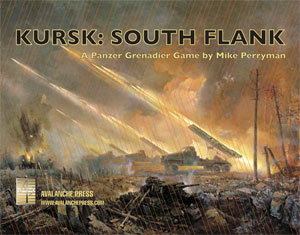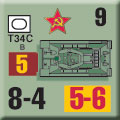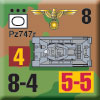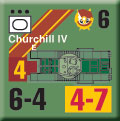| Kursk South Flank:
Publisher’s Preview
By Mike Bennighof, Ph.D.
January 2021
 Panzer Grenadier: Kursk South Flank, despite its ungainly title, is the game that re-launched Panzer Grenadier and Avalanche Press itself. So I’ve always had a certain fondness for it, but we’ve never given it the Publisher Overview treatment. Let’s fix that. Panzer Grenadier: Kursk South Flank, despite its ungainly title, is the game that re-launched Panzer Grenadier and Avalanche Press itself. So I’ve always had a certain fondness for it, but we’ve never given it the Publisher Overview treatment. Let’s fix that.
Mike Perryman originally conceived South Flank as part of a much larger game, but South Flank retains only its unwieldy title as a reminder of its origins. It’s a little larger than what we consider the ideal production standard for Panzer Grenadier games, with 693 pieces (528 units and leaders, 165 markers) rather than the typical 517 (352 units and leaders, 165 markers). Those are used on four geomorphic map boards (meaning that you arrange the separate map pieces to make the final game map).
The extra pieces come from the presence of three distinct forces on the Kursk battlefield in this sector: the German Waffen SS armed criminal militia on one side and the Red Army of Workers and Peasants regulars (RKKA) and Guards on the other. Each of them brings the full array of troops, tanks, weapons and leaders, so we had to have them all.
 The armies are at their peak; the Waffen SS managed to avoid the losses of the Stalingrad campaign and have gained a great deal more operational skill than they showed in their early, bumbling attempts at mechanized warfare. The regular Army’s defeat at Stalingrad has instead elevated Himmler’s uniformed thugs in the feudal struggle for Hitler’s favor, and now they wield the very best weapons available to the Third Reich, and plenty of them. The armies are at their peak; the Waffen SS managed to avoid the losses of the Stalingrad campaign and have gained a great deal more operational skill than they showed in their early, bumbling attempts at mechanized warfare. The regular Army’s defeat at Stalingrad has instead elevated Himmler’s uniformed thugs in the feudal struggle for Hitler’s favor, and now they wield the very best weapons available to the Third Reich, and plenty of them.
Most of the Waffen SS tanks are the late-model PzKpfw IIIJ medium tank with a long-barreled 50mm gun; it’s not quite as good as the Soviet T-34/76 but much closer in fighting power than earlier models. They also have a fair number of the new PzKpfw IVH medium tank with a long-barreled 75mm gun; after two years of war against the Soviets the Germans finally have a better tank than the T-34. The slightly older PzKpfw IVF2 isn’t quite as good, but is a match for the older-model T-34’s, and the 3rd SS Panzer Grenadier Division has some captured T-34/76 tanks, which obviously are a match for their Soviet counterparts.
 What the Waffen SS does have is the Tiger tank: much tougher than any other tank in the game, with a bigger cannon than anyone else that can shred a T-34 at a great distance. Its only weakness is that it’s not a suitable main battle tank; it’s simply much too slow. So the Tigers usually hunt in packs, showing up at key points where the action has slowed down to their pace. What the Waffen SS does have is the Tiger tank: much tougher than any other tank in the game, with a bigger cannon than anyone else that can shred a T-34 at a great distance. Its only weakness is that it’s not a suitable main battle tank; it’s simply much too slow. So the Tigers usually hunt in packs, showing up at key points where the action has slowed down to their pace.
Along with better tanks, the Waffen SS also fields better infantry and very large machine-gun platoons. They have the best anti-tank guns Germany can offer (the new 75mm) and armored personnel carriers to bring the troops into battle.
 The Soviets, for their part, have finally figured out how to apply the theory of armored warfare to actual practice. Both the Soviets Guards and the RKKA bring the same infantry, machine gun and support weapon units seen throughout the war. The “Katyusha” multiple rocket launch system is now in more common use, but these are the same basic units seen in Panzer Grenadier games stretching from Ukraine 1941 (Fire in the Steppe) through Manchuria 1945 (The Last Campaign). The Soviets, for their part, have finally figured out how to apply the theory of armored warfare to actual practice. Both the Soviets Guards and the RKKA bring the same infantry, machine gun and support weapon units seen throughout the war. The “Katyusha” multiple rocket launch system is now in more common use, but these are the same basic units seen in Panzer Grenadier games stretching from Ukraine 1941 (Fire in the Steppe) through Manchuria 1945 (The Last Campaign).
Both the Guards and the RKKA field a tank park built around the T-34/76, in three models (A, B and C) which differ only slightly in combat capability. There are also a relatively large number of T-70 light tanks; while the Stavka was well aware that these had little place in a tank battle, they could be built on automotive assembly lines that could not handle bigger tanks like the T-34, and so they continued to arrive at the front (soon the factories would begin building more useful self-propelled guns instead). The late-war Soviet models, like the war-winning T-34/85 and the JS series of heavy tanks, have not yet made their appearance in battle.
 The Battle of Kursk took place in July 1943, and is usually considered the turning point of the Great Patriotic War. The massive battle itself did not yield a decisive result, but afterwards the Germans would never again go on the strategic offensive. This is the tipping point, that moment where both sides are capable of seizing the initiative. The Battle of Kursk took place in July 1943, and is usually considered the turning point of the Great Patriotic War. The massive battle itself did not yield a decisive result, but afterwards the Germans would never again go on the strategic offensive. This is the tipping point, that moment where both sides are capable of seizing the initiative.
The Germans made their attack as a pincer movement, with two distinct forces assaulting the Soviet-held salient around Kursk from the north and the south. South Flank covers, well, the south flank, where Fourth Panzer Army spearheaded the German effort, with three panzer corps of its own and an additional panzer corps on its right flank. Those panzer troops included the three divisions of the II Ss Panzer Corps and the Grossdeutschland Panzer Grenadier Division.
 The Soviets initially opposed the southern attack with Sixth and Seventh Guards Armies, dug in along three well-fortified lines and supported by the thickest minefields yet sown in this war plus many additional anti-tank batteries. First Guards Army and First Tank Army would be committed as reinforcements, along with more separate corps and divisions. The Soviets initially opposed the southern attack with Sixth and Seventh Guards Armies, dug in along three well-fortified lines and supported by the thickest minefields yet sown in this war plus many additional anti-tank batteries. First Guards Army and First Tank Army would be committed as reinforcements, along with more separate corps and divisions.
The climax of the battle took place at Prokhorovkha, where Fifth Guards Tank Army met the II SS Panzer Corps head on. The huge clash of armor proved a stalemate: the Soviets could not push the Germans back, but neither could the Germans break through to their objectives.
 South Flank covers these battles in 40 scenarios, with 15 of the 40 drawn from the battles in and around Prokhorovka. As befits a game on the Battle of Kursk, there’s a much larger proportion of tank battles than in most other games in the series, including some huge clashes of armor. But after close to two decades of making Panzer Grenadier games we know that players want variety, if only to match their available game time, so we’ve got a nice selection of single-map, half-and-evening scenarios, too (this is why we publish to many of them in each game, to make sure there’s something in there for every mood or situation where you want to play a game). South Flank covers these battles in 40 scenarios, with 15 of the 40 drawn from the battles in and around Prokhorovka. As befits a game on the Battle of Kursk, there’s a much larger proportion of tank battles than in most other games in the series, including some huge clashes of armor. But after close to two decades of making Panzer Grenadier games we know that players want variety, if only to match their available game time, so we’ve got a nice selection of single-map, half-and-evening scenarios, too (this is why we publish to many of them in each game, to make sure there’s something in there for every mood or situation where you want to play a game).
Even so, South Flank was designed as the ultimate tank battle game, and that’s what it delivers: Waffen SS and Soviet Guards armor fighting it out with the future of the world at stake. This is what wargaming is all about.
Play the game! Order South Flank right now!
Sign up for our newsletter right here. Your info will never be sold or transferred; we'll just use it to update you on new games and new offers.
Mike Bennighof is president of Avalanche Press and holds a doctorate in history from Emory University. A Fulbright Scholar and NASA Journalist in Space finalist, he has published countless books, games and articles on historical subjects.
He lives in Birmingham, Alabama with his wife, three children and his dog, Leopold. |
